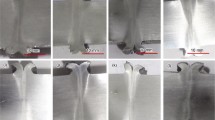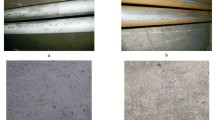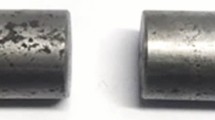Abstract
Friction welding is a solid-state joining process which is applied extensively because of its advantages such as low heat input, efficient application, ease in manufacturing, and environmental friendliness. The present study investigates the mechanical and metallurgical properties of UNS S32205 duplex stainless steel friction-welded joints. The process parameters, namely friction pressure, upsetting pressure, and rotational speed are individually varied from low level to high level (within the range of the machine setup) and their effects on the joint properties are analyzed. The partial-deformation zone had higher hardness than the weld and base metal. The toughness of the joints was evaluated at room temperature and at subzero temperature conditions. The impact toughness of the friction-welded joints was found to be superior to fusion-joined duplex stainless steel in room and cryogenic conditions.
Article PDF
Similar content being viewed by others
References
Charles J. Composition and properties of duplex stainless steels. Welding in the World36: 43–54 (1995)
Vogt J B. Fatigue properties of high nitrogen steels. Mater Proc Tech117: 364–369 (2001)
Mateo A, Llanes L, Akdut N, Anglada M. High cycle fatigue behavior of a standard duplex stainless steel plate and bar. Mater Sci Eng A319–321: 516–520 (2001)
Hertzman S, Lehtinen B, Symniotis-Barradal E. Intermetallic phase formation and its effect on corrosion resistance of duplex stainless steel SS 2377 (UNS 31803). In Proceedings of Applications of Stainless Steel’ 92, Stockholm, Sweden, 1992: 345–359.
Gunn R N. Reduction in fracture toughness due to intermetallic precipitates in duplex stainless steels. In Duplex America 2000 Conference on Duplex Stainless Steels, Houston, USA, 2000: 299–314.
Nilsson J O. Super duplex stainless steels. Mater Sci Tech8: 685–700 (1992)
Thorvaldsson T, Eriksson H, Kutka J, Salwén A. Influence of microstructure on mechanical properties of a duplex stainless steel. In Proceedings of Stainless Steel’ 84, Göteborg, Sweden, 1984: 101–105.
Karlsson L, Bengtsson L, Rolander U, Pak S. The kinetics of intermetallic phase formation in duplex stainless weld metals and their influence on mechanical properties. In Proceedings of Applications of Stainless Steel’ 92, Stockholm, Sweden, 1992: 335–344.
Karlsson L. Duplex stainless steel weld metals-effects of secondary phases. In Proceedings of Duplex Stainless Steels’ 97, Maastricht, Netherlands, 1997: 43–58.
Karlsson L, Rigdal S, Lake F. Effects of intermetallic phases in duplex stainless steel weldments. In Duplex America 2000 Conference on Duplex Stainless Steels, Houston, USA, 2000: 257–272.
Liljas M. The welding metallurgy of duplex stainless steels. In Proceedings of Duplex Stainless steels’ 94, Glasgow, Scotland, 1994.
Sato Y S, Nelson T W, Sterling C J, Steel R K. Pettersson C O. Microstructure and mechanical properties of friction stir welded SAF 2507 super duplex stainless steel. Mater Sci Eng A397: 376–384 (2005)
Cvijović ZM, Mihajlović D V, Knežević V R. Microstructural morphology and stability of rapidly solidified duplex stainless steel. Mat Sci Forum282–283: 323–330 (1998)
Li J, Zhang X, Liu L, Han L. Interfacial characteristics and dynamic process of Au- and Cu-wire bonding and overhang bonding in microelectronics packaging. J Microelectromech S22(3): 560–568 (2013)
Li J, Liu L, Deng L, Ma B, Wang F, Han L. Interfacial microstructures and thermodynamics of thermosonic Cu-wire bonding. IEEE Electron Devic Lett32(10): 1433–1435 (2011)
Li J, Han L, Duan J, Zhong J. Interface mechanism of ultrasonic flip chip bonding. Appl Phys Lett90(24): 242902 (2007)
Li J, Duan J, Han L, Zhong J. Microstructural characteristics of Au/Al bonded interfaces. Mater Charact58: 103–107 (2007)
Li J, Wang F, Han L, Zhong J. Theoretical and Experimental Analyses of Atom Diffusion Characteristics on Wire Bonding Interfaces. J Phys D: Appl Phys41: 135303 (2008)
Sahin M. Evaluation of the joint-interface properties of austenitic-stainless steels (AISI 304) joined by friction welding. J Mater Des28: 2244–2250 (2007)
Heino S, Knutson-wedel E M, Karlsson B. Precipitation behavior in heat affected zone of welded super austenitic stainless steel. J Mater Sci Technol15(1): 101–108 (1999)
Suutala N. Effect of solidification conditions on the solidification mode in austenitic stainless steels. Metall Mater Trans A14: 191–197 (1983)
Ibrahim O H, Ibrahim I S, Khalifa T A F. Impact behavior of different stainless steel weldments at low temperature. Eng Fail Anal17: 1069–1076 (2010)
Baek J-H, Kim Y-P, Kim W-S, Kho Y-T. Effect of temperature on the charpy impact and CTOD values of type 304 stainless steel pipeline for LNG transmission. J Mech Sci Technol16(8): 1064–1071 (2002)
Chan J W. Small punch testing for determining the cryogenic fracture properties of 304 and 316 austenitic stainless steels. Adv Cryogenic Eng55: 38–45 (1992)
Han G, Fukuyama S. Yokogawa K. Tensile behavior of duplex stainless steel at low temperatures. Mater Sci Technol15: 909–920 (1999)
Kacar R, Acarer M. Microstructure-property relationship in welded duplex stainless steels. Mater Sci Eng A363: 290–296 (2003)
Sieurin H, Sandstom R. Fracture toughness of a welded duplex stainless steel. Eng Fract Mech73: 377–390 (2006)
Author information
Authors and Affiliations
Corresponding author
Additional information
This article is published with open access at Springerlink.com
Puthuparambil Madhavan AJITH. He is a PhD candidate at Department of Production Engineering, National Institute of Technology, Tiruchirappalli, Tamil Nadu, India. He obtained his Bachelor degree in 1994 from Mahatma Gandhi University, Kottayam, Kerala, India and Master degree in 2009 from National Institute of Technology, Tiruchirappalli, Tamil Nadu, India. He is also currently working as associate professor, Department of Mechanical Engineering, Rajiv Gandhi Institute of Technology Government Engineering college, Kottayam, Kerala, India. His research areas include welding and optimization of parameters with different technique.
Paulraj SATHIYA. He received his bachelor degree in 1994 on Mechanical Engineering from Government college of Engineering, Salem, University of Madras, India, his Master degree in 1996 on Welding Engineering from Regional Engineering College, Bharathidasan University, India, and his PhD degree in 2006 from Bharathidasan University, India. He is currently working as an associate professor in Department of Production Engineering and associate dean (Planning & Development) in National Institute of Technology, Trichy, Tamilnadu, India. He is working in the area of welding technology, solid state joining, materials behaviour subjected to welding, similar and dissimilar materials welding, failure analysis of weldments, modeling and simulation of welding processes, and welding parameter optimization. He received Young Technology Award 2009, from Indian Welding Society, India and also received Young Scientist Award from Department of Science and Technology, New Delhi, India. He has published sixty papers in international and national reputed journals and fifty papers in international and national conferences.
Sivanandam Aravindan. He received his Bachelor degree in Mechanical Engineering in 1990 from Bharathidasan University. He received Masters degree in Manufacturing Technology in 1993 from Annamalai University. He obtained PhD degree in 2000 from IITM, Chennai. After that, he did his post doctoral fellowship (JSPS) at Tokyo Institute of technology in Nano technology area. He is currently working as a associate professor in Department of Mechanical Engineering, Indian Institute of Technology Delhi, Delhi, India. He is working in the area of welding, advanced materials processing and nano manufacturing. He received 2 best paper awards in national and international conferences. He filed two Indian patents. He successfully completed two funded projects. He published fifty five papers in international and national reputed journals and seventy papers in International and national conferences.
Rights and permissions
Open Access This article is licensed under a Creative Commons Attribution 4.0 International License, which permits use, sharing, adaptation, distribution and reproduction in any medium or format, as long as you give appropriate credit to the original author(s) and the source, provide a link to the Creative Commons licence, and indicate if changes were made.
The images or other third party material in this article are included in the article’s Creative Commons licence, unless indicated otherwise in a credit line to the material. If material is not included in the article’s Creative Commons licence and your intended use is not permitted by statutory regulation or exceeds the permitted use, you will need to obtain permission directly from the copyright holder.
To view a copy of this licence, visit https://creativecommons.org/licenses/by/4.0/.
About this article
Cite this article
Ajith, P.M., Sathiya, P. & Aravindan, S. Characterization of microstructure, toughness, and chemical composition of friction-welded joints of UNS S32205 duplex stainless steel. Friction 2, 82–91 (2014). https://doi.org/10.1007/s40544-014-0042-6
Received:
Revised:
Accepted:
Published:
Issue Date:
DOI: https://doi.org/10.1007/s40544-014-0042-6




